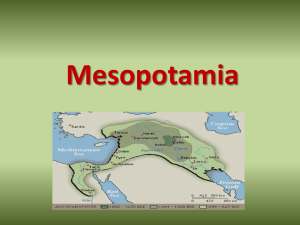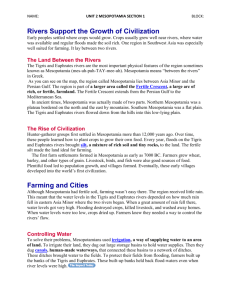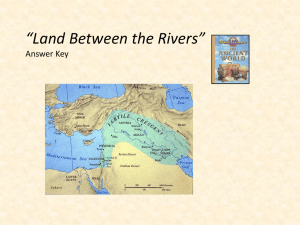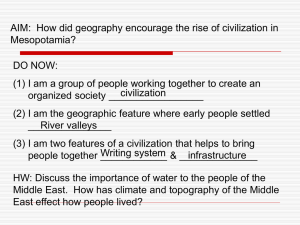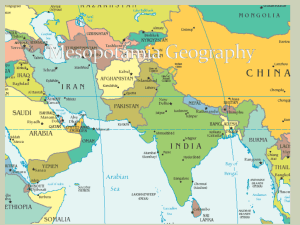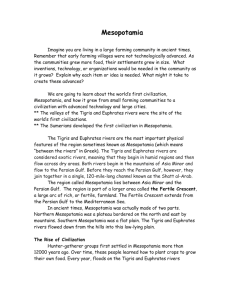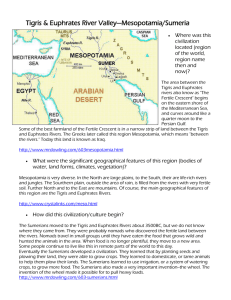Geography of the Fertile Crescent IfYOUwere there…
advertisement
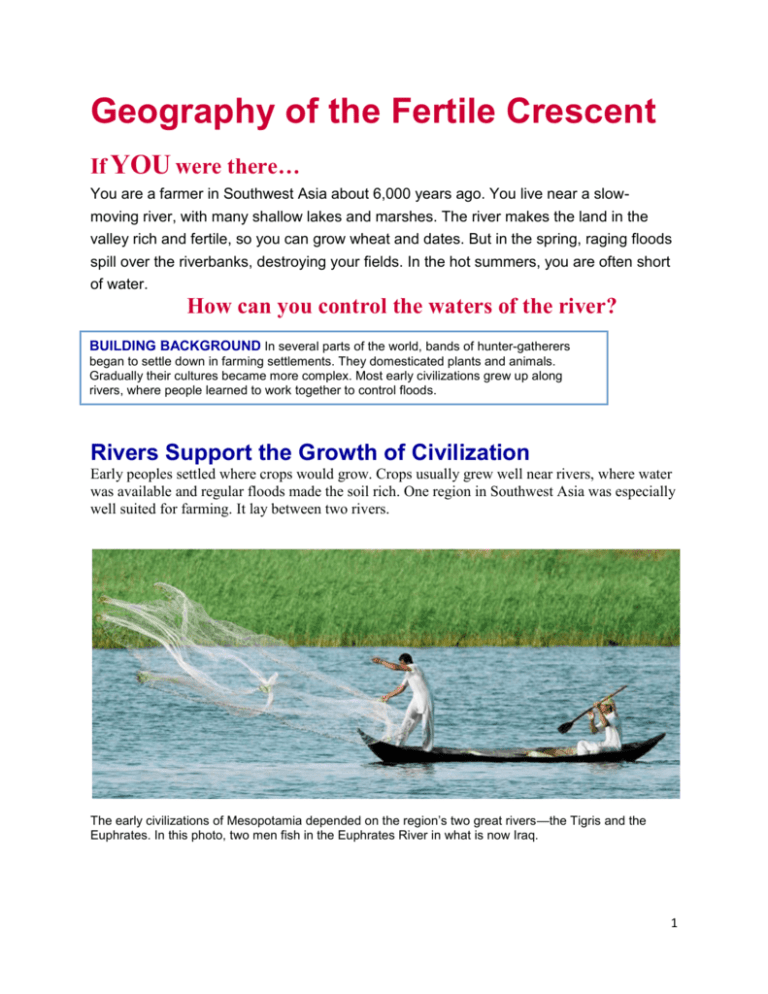
Geography of the Fertile Crescent If YOU were there… You are a farmer in Southwest Asia about 6,000 years ago. You live near a slowmoving river, with many shallow lakes and marshes. The river makes the land in the valley rich and fertile, so you can grow wheat and dates. But in the spring, raging floods spill over the riverbanks, destroying your fields. In the hot summers, you are often short of water. How can you control the waters of the river? BUILDING BACKGROUND In several parts of the world, bands of hunter-gatherers began to settle down in farming settlements. They domesticated plants and animals. Gradually their cultures became more complex. Most early civilizations grew up along rivers, where people learned to work together to control floods. Rivers Support the Growth of Civilization Early peoples settled where crops would grow. Crops usually grew well near rivers, where water was available and regular floods made the soil rich. One region in Southwest Asia was especially well suited for farming. It lay between two rivers. The early civilizations of Mesopotamia depended on the region’s two great rivers—the Tigris and the Euphrates. In this photo, two men fish in the Euphrates River in what is now Iraq. 1 The Land Between the Rivers The Tigris and Euphrates rivers are the most important physical features of the region sometimes known as Mesopotamia (mes-uh-puh-TAY-mee-uh). Mesopotamia means “between the rivers” in Greek. As you can see on the map, the region called Mesopotamia lies between Asia Minor and the Persian Gulf. The region is part of a larger area called the Fertile Crescent, a large arc of rich, or fertile, farmland. The Fertile Crescent extends from the Persian Gulf to the Mediterranean Sea. In ancient times, Mesopotamia was actually made of two parts. Northern Mesopotamia was a plateau bordered on the north and the east by mountains. Southern Mesopotamia was a flat plain. The Tigris and Euphrates rivers flowed down from the hills into this low-lying plain. The Rise of Civilization Hunter-gatherer groups first settled in Mesopotamia more than 12,000 years ago. Over time, these people learned how to plant crops to grow their own food. Every year, floods on the Tigris and Euphrates rivers brought silt, a mixture of rich soil and tiny rocks, to the land. The fertile silt made the land ideal for farming. The first farm settlements formed in Mesopotamia as early as 7000 BC. Farmers grew wheat, barley, and other types of grain. Livestock, birds, and fish were also good sources of food. Plentiful food led to population growth, and villages formed. Eventually, these early villages developed into the world’s first civilization. What made civilization possible in Mesopotamia? In what general direction do the Tigris and Euphrates rivers flow on their way to the Persian Gulf? 2 Early farmers faced the challenge of learning how to control the flow of river water to their fields in both rainy and dry seasons. 1. Early settlements in Mesopotamia were located near rivers. Water was not controlled, and flooding was a major problem. 2. Later, people built canals to protect houses from flooding and move water to their fields. 3. With irrigation, the people of Mesopotamia were able to grow more food. 4. Food surpluses allowed some people to stop farming and concentrate on other jobs, like making clay pots or tools. Farming and Cities Although Mesopotamia had fertile soil, farming wasn’t easy there. The region received little rain. This meant that the water levels in the Tigris and Euphrates rivers depended on how much rain fell in eastern Asia Minor where the two rivers began. When a great amount of rain fell there, water levels got very high. Flooding destroyed crops, killed livestock, and washed away homes. When water levels were too low, crops dried up. Farmers knew they needed a way to control the rivers’ flow. 3 Controlling Water To solve their problems, Mesopotamians used irrigation, a way of supplying water to an area of land. To irrigate their land, they dug out large storage basins to hold water supplies. Then they dug canals, human-made waterways, that connected these basins to a network of ditches. These ditches brought water to the fields. To protect their fields from flooding, farmers built up the banks of the Tigris and Euphrates. These built-up banks held back flood-waters even when river levels were high. Food Surpluses Irrigation increased the amount of food farmers were able to grow. In fact, farmers could produce a food surplus, or more than they needed. Farmers also used irrigation to water grazing areas for cattle and sheep. As a result, Mesopotamians ate a variety of foods. Fish, meat, wheat, barley, and dates were plentiful. Because irrigation made farmers more productive, fewer people needed to farm. Some people became free to do other jobs. As a result, new occupations developed. For the first time, people became crafters, religious leaders, and government workers. The type of arrangement in which each worker specializes in a particular task or job is called a division of labor. Having people available to work on different jobs meant that society could accomplish more. Large projects, such as constructing buildings and digging irrigation systems, required specialized workers, managers, and organization. To complete these projects, the Mesopotamians needed structure and rules. Structure and rules could be provided by laws and government. The Appearance of Cities Over time, Mesopotamian settlements grew in size and complexity. They gradually developed into cities between 4000 and 3000 BC. Despite the growth of cities, society in Mesopotamia was still based on agriculture. Most people still worked in farming jobs. However, cities were becoming important places. People traded goods there, and cities provided leaders with power bases. They were the political, religious, cultural, and economic centers of civilization. Why did the Mesopotamians create irrigation systems? SUMMARY AND PREVIEW Mesopotamia’s rich, fertile lands supported productive farming, which led to the development of cities. In the next section you will learn about some of the first city builders. Where was Mesopotamia? How did the Fertile Crescent get its name? What was the most important factor in making Mesopotamia’s farmland fertile? Why did farmers need to develop a system to control their water supply? In what ways did a division of labor contribute to the growth of Mesopotamian civilization? How might running large projects prepare people for running a government? 4 River Valley Civilizations All of the world’s earliest civilizations had something in common—they all arose in river valleys that were perfect locations for farming. Three key factors made river valleys good for farming. First, the fields that bordered the rivers were flat, which made it easier for farmers to plant crops. Second, the soils were nourished by flood deposits and silt, which made them very fertile. Finally, the river provided the water farmers needed for irrigation. Why did the first civilizations all develop in river valleys? Where were the four earliest river valley civilizations located? 5

